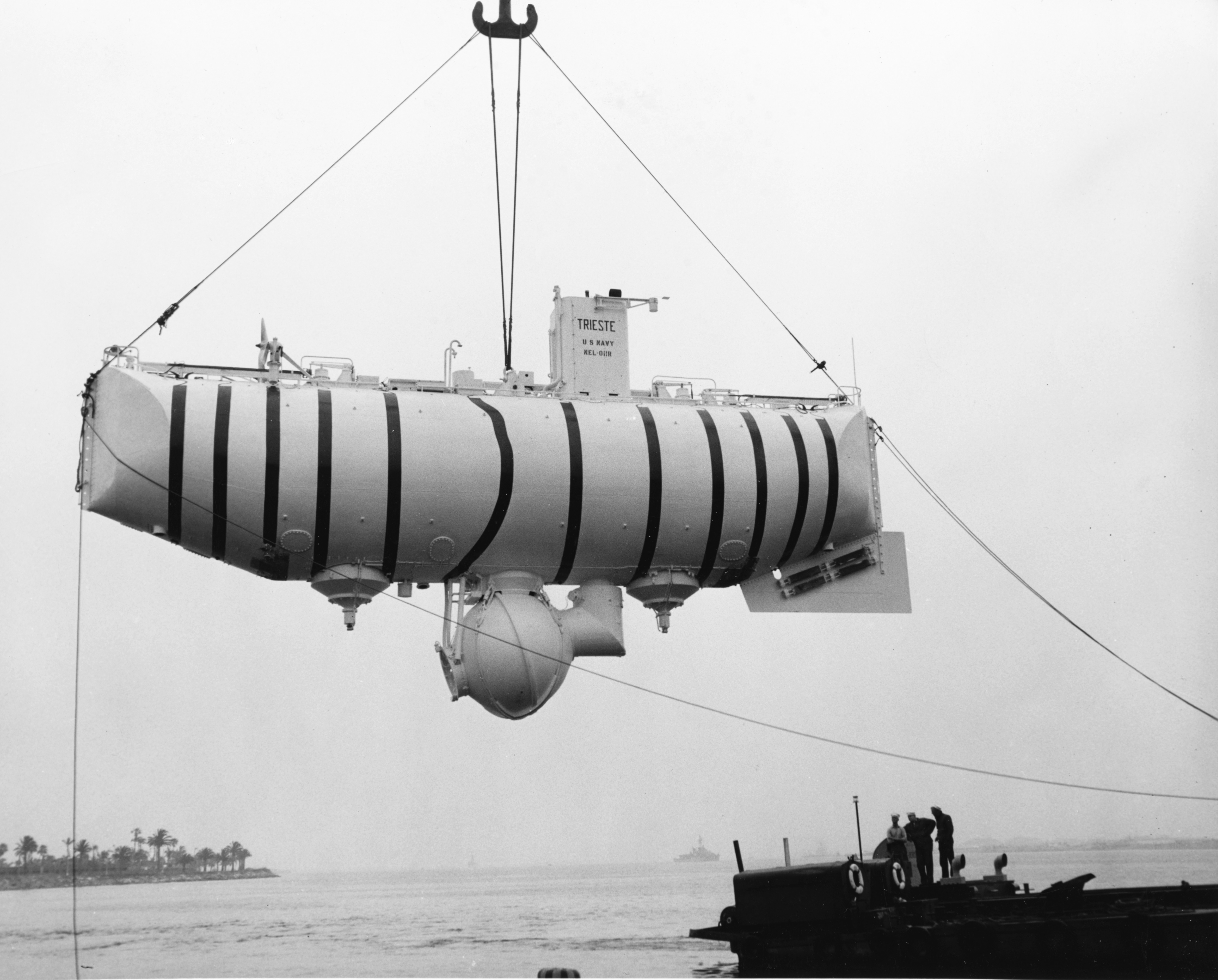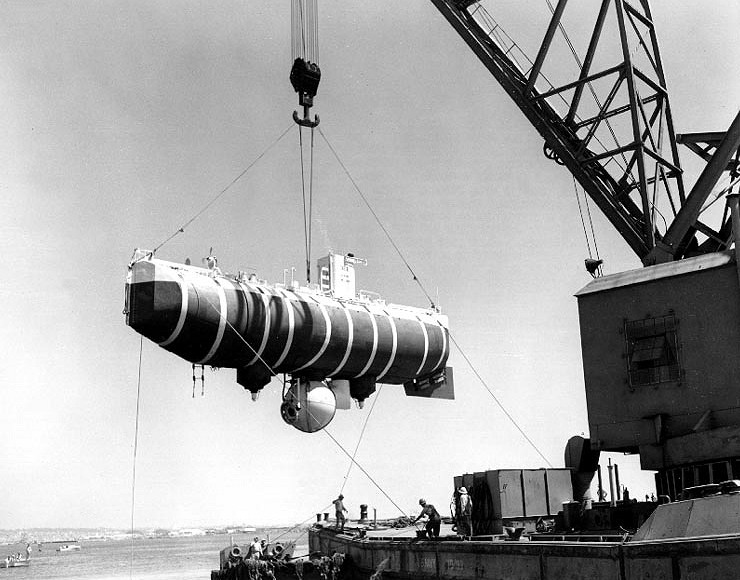|
FNRS-2
The ''FNRS-2'' was the first bathyscaphe. It was created by Auguste Piccard. Work started in 1937 but was interrupted by World War II. The deep-diving submarine was finished in 1948. The bathyscaphe was named after the Belgian Fonds National de la Recherche Scientifique (FNRS), the funding organization for the venture. FNRS also funded the ''FNRS-1'' which was a balloon that set a world altitude record, also built by Piccard. The ''FNRS-2'' set world diving records, besting those of the bathyspheres, as no unwieldy cable was required for diving. It was in turn bested by a more refined version of itself, the bathyscaphe ''Trieste''. ''FNRS-2'' was built from 1946 to 1948. It was damaged during sea trials in 1948, off the Cape Verde Islands.''Encyclopædia Britannica'', 2010 Online, 9 September 2010 (accessed 9 September 2010) ''FNRS-2'' was sold to the French Navy when FNRS funding ran low, in 1948. The French rebuilt and rebaptised it ''FNRS-3''. It was eventually replaced by ... [...More Info...] [...Related Items...] OR: [Wikipedia] [Google] [Baidu] |
Bathyscaphe
A bathyscaphe ( or ) is a free-diving self-propelled deep-sea submersible, consisting of a crew cabin similar to a bathysphere, but suspended below a float rather than from a surface cable, as in the classic bathysphere design. The float is filled with gasoline because it is readily available, buoyant, and, for all practical purposes, incompressible. The incompressibility of the gasoline means the tanks can be very lightly constructed, since the pressure inside and outside the tanks equalises, eliminating any differential. By contrast, the crew cabin must withstand a huge pressure differential and is massively built. Buoyancy at the surface can be trimmed easily by replacing gasoline with water, which is denser. Auguste Piccard, inventor of the first bathyscaphe, composed the name ''bathyscaphe'' using the Ancient Greek words βαθύς ''bathys'' ("deep") and σκάφος ''skaphos'' ("vessel"/"ship"). Mode of operation To descend, a bathyscaphe floods air tanks with s ... [...More Info...] [...Related Items...] OR: [Wikipedia] [Google] [Baidu] |
Auguste Piccard
Auguste Antoine Piccard (28 January 1884 – 24 March 1962) was a Swiss physicist, inventor and explorer known for his record-breaking hydrogen balloon flights, with which he studied the Earth's upper atmosphere. Piccard was also known for his invention of the first bathyscaphe, '' FNRS-2'', with which he made a number of unmanned dives in 1948 to explore the ocean's depths. Piccard's twin brother Jean Felix Piccard is also a notable figure in the annals of science and exploration, as are a number of their relatives, including Jacques Piccard, Bertrand Piccard, Jeannette Piccard and Don Piccard. Biography Piccard and his twin brother Jean Felix Piccard were born in Basel, Switzerland, on 28 January 1884. Showing an intense interest in science as a child, he attended the Swiss Federal Institute of Technology (ETH) in Zürich and became a professor of physics in Brussels at the Free University of Brussels in 1922, the same year his son Jacques Piccard was born. ... [...More Info...] [...Related Items...] OR: [Wikipedia] [Google] [Baidu] |
FNRS-1
The FNRS-1 was a balloon, built by Auguste Piccard, that set a world altitude record. It was named after the Belgian Fonds National de la Recherche Scientifique, which funded the balloon. References and notes Sources * * * See also * National Fund for Scientific Research * FNRS-2, which was the first ever bathyscaphe built. * FNRS-3 The ''FNRS-3'' or ''FNRS III'' is a bathyscaphe of the French Navy. It is currently preserved at Toulon. She set world depth records, competing against a more refined version of her design, the ''Trieste''. The French Navy eventually replaced h ..., which was rebuilt from FNRS-2 Individual balloons (aircraft) Aircraft manufactured in Belgium {{Belgium-stub ... [...More Info...] [...Related Items...] OR: [Wikipedia] [Google] [Baidu] |
Deep-submergence Vehicle
A deep-submergence vehicle (DSV) is a deep-diving crewed submersible that is self-propelled. Several navies operate vehicles that can be accurately described as DSVs. DSVs are commonly divided into two types: research DSVs, which are used for exploration and surveying, and DSRVs (Deep Submergence Rescue Vehicle), which can be used for rescuing the crew of a sunken navy submarine, clandestine (espionage) missions (primarily installing wiretaps on undersea communications cables), or both. DSRVs are equipped with docking chambers to allow personnel ingress and egress via a manhole. The real-life feasibility of any DSRV-based rescue attempt is hotly debated, because the few available docking chambers of a stricken submarine may be flooded, trapping the sailors still alive in other dry compartments. The only attempt to rescue a stricken submarine with these so far (the Russian submarine ''Kursk'') ended in failure as the entire crew who survived the explosion had either suffocated o ... [...More Info...] [...Related Items...] OR: [Wikipedia] [Google] [Baidu] |
FNRS-3
The ''FNRS-3'' or ''FNRS III'' is a bathyscaphe of the French Navy. It is currently preserved at Toulon. She set world depth records, competing against a more refined version of her design, the ''Trieste''. The French Navy eventually replaced her with the bathyscaphe '' FNRS-4'', in the 1960s.Paine, Lincoln P. (1997). ''Ships of the World''. Houghton Mifflin. p. 188. After damage to the ''FNRS-2'' during its sea trials in 1948, the Fonds National de la Recherche Scientifique (FNRS) ran out of funding, and the submersible was sold to the French Navy, in 1950. She was subsequently substantially rebuilt and improved at Toulon naval base, and renamed ''FNRS-3''.'' Encyclopædia Britannica'', 2010 Online, 9 September 2010 (accessed 9 September 2010) She was relaunched in 1953, under the command of Georges Houot, a French naval officer. On 15 February 1954, she made a dive 160 miles off Dakar, Senegal, in the Atlantic Ocean, beating Piccard's 1953 record, set by the ''Trieste' ... [...More Info...] [...Related Items...] OR: [Wikipedia] [Google] [Baidu] |
Trieste II (Bathyscaphe)
''Trieste II'' (DSV-1) was the successor to ''Trieste''—the United States Navy's first bathyscaphe purchased from its Swiss designers. History The original ''Trieste'' design was heavily modified by the Naval Electronics Laboratory in San Diego, California and built at the Mare Island Naval Shipyard. ''Trieste II'' incorporated the original Terni, Italian-built sphere used in ''Trieste'', after it was made redundant by the new high-pressure sphere cast by the German Krupp Steelworks. The ''Trieste'' sphere was suspended from an entirely new float, more seaworthy and streamlined than the original but operating on identical principles. Completed in early 1964, ''Trieste II'' was placed on board USNS ''Francis X. McGraw'' (T-AK241) and shipped, via the Panama Canal, to Boston. Commanded by Lt Comdr. John B. Mooney Jr., with co-pilot Lt. John H. Howland and Capt. Frank Andrews, ''Trieste II'' conducted dives in the vicinity of the loss site of —operations commenced by the fi ... [...More Info...] [...Related Items...] OR: [Wikipedia] [Google] [Baidu] |
NFWO
The National Fund for Scientific Research (NFSR) (Dutch: ''Nationaal Fonds voor Wetenschappelijk Onderzoek'' (NFWO), French: ''Fonds National de la Recherche Scientifique'' (FNRS)) was once a government institution in Belgium for supporting scientific research until it was split into two separate organizations: * the Dutch-speaking '' Fonds Wetenschappelijk Onderzoek – Vlaanderen'' (FWO) (Research Foundation – Flanders) for the Flemish Community and * the French-speaking ''Fonds de la Recherche Scientifique – FNRS'' (F.R.S.–FNRS) for the French Community. The task of the FWO and F.R.S.–FNRS is to stimulate the development of new knowledge in all scientific disciplines. The means to achieve this, is to finance excellent scientists and research projects after an inter-University competition and with an evaluation by foreign experts. The criterion for support is the scientific quality of the scientist and the research proposal, irrespective of scientific discipline. Both ... [...More Info...] [...Related Items...] OR: [Wikipedia] [Google] [Baidu] |
Trieste (bathyscaphe)
''Trieste'' is a Swiss-designed, Italian-built deep-diving research bathyscaphe which reached a record depth of about in the Challenger Deep of the Mariana Trench near Guam in the Pacific. On 23 January 1960, Jacques Piccard (son of the boat's designer Auguste Piccard) and US Navy Lieutenant Don Walsh achieved the goal of Project Nekton. It was the first crewed vessel to reach the bottom of the Challenger Deep. Design ''Trieste'' consisted of a float chamber filled with gasoline (petrol) for buoyancy, with a separate pressure sphere to hold the crew. This configuration (dubbed a "bathyscaphe" by the Piccards) allowed for a free dive, rather than the previous bathysphere designs in which a sphere was lowered to depth and raised again to the surface by a cable attached to a ship. ''Trieste'' was designed by the Swiss scientist Auguste Piccard and originally built in Italy. His pressure sphere, composed of two sections, was built by Acciaierie Terni. The upper part was manufact ... [...More Info...] [...Related Items...] OR: [Wikipedia] [Google] [Baidu] |
Bathyscaphe Trieste
''Trieste'' is a Swiss-designed, Italian-built deep-diving research bathyscaphe which reached a record depth of about in the Challenger Deep of the Mariana Trench near Guam in the Pacific. On 23 January 1960, Jacques Piccard (son of the boat's designer Auguste Piccard) and US Navy Lieutenant Don Walsh achieved the goal of Project Nekton. It was the first crewed vessel to reach the bottom of the Challenger Deep. Design ''Trieste'' consisted of a float chamber filled with gasoline (petrol) for buoyancy, with a separate pressure sphere to hold the crew. This configuration (dubbed a "bathyscaphe" by the Piccards) allowed for a free dive, rather than the previous bathysphere designs in which a sphere was lowered to depth and raised again to the surface by a cable attached to a ship. ''Trieste'' was designed by the Swiss scientist Auguste Piccard and originally built in Italy. His pressure sphere, composed of two sections, was built by Acciaierie Terni. The upper part was manu ... [...More Info...] [...Related Items...] OR: [Wikipedia] [Google] [Baidu] |
Time (magazine)
''Time'' (stylized in all caps) is an American news magazine based in New York City. For nearly a century, it was published Weekly newspaper, weekly, but starting in March 2020 it transitioned to every other week. It was first published in New York City on March 3, 1923, and for many years it was run by its influential co-founder, Henry Luce. A European edition (''Time Europe'', formerly known as ''Time Atlantic'') is published in London and also covers the Middle East, Africa, and, since 2003, Latin America. An Asian edition (''Time Asia'') is based in Hong Kong. The South Pacific edition, which covers Australia, New Zealand, and the Pacific Islands, is based in Sydney. Since 2018, ''Time'' has been published by Time USA, LLC, owned by Marc Benioff, who acquired it from Meredith Corporation. History ''Time'' has been based in New York City since its first issue published on March 3, 1923, by Briton Hadden and Henry Luce. It was the first weekly news magazine in the United St ... [...More Info...] [...Related Items...] OR: [Wikipedia] [Google] [Baidu] |
Georges Houot
Georges Houot (29 August 1913 – 7 August 1977) was a French naval officer and commander of a bathyscaphe unit. Biography He was born in Paris and educated at the Prytanée militaire military school at La Flèche in the Pays de la Loire region. In 1933 he entered the Naval College near Brest in Brittany where he trained to be a torpedo officer. As an officer he served on the cruiser ''Gloire'' from 1940 to 1941, the destroyer ''Hardi'' in 1942 and the frigates ''Croix-de-Lorraine'' (1945–47) and ''Lac Pavin'' (1947–49). In 1949, Houot succeeded Jacques Cousteau as commander of the underwater research vessel, ''Élie Monnier'', which was used for exploring the sea bed. In spite of suffering from the after-effects of polio he took part in the diving activities of the men under his command and developed an interest in underwater research. In 1951 he was chosen to direct the trials of the ''FNRS III'' bathyscaphe, and in 1953 was given overall command of the bathyscaphes. On ... [...More Info...] [...Related Items...] OR: [Wikipedia] [Google] [Baidu] |
_01.jpg)



